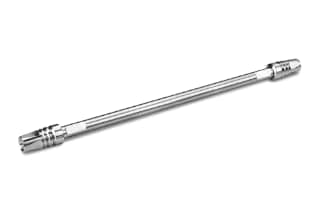
|
Chemistry |
C8 |
|
Separation Mode |
Reversed Phase |
|
Particle Substrate |
Silica |
|
pH Range Min |
2 pH |
|
pH Range Max |
8 pH |
|
Temperature Limits |
45 C |
|
Maximum Pressure |
18000 psi (1240 Bar) |
|
Endcapped |
Yes |
|
Silanol Activity |
Low |
|
Particle Shape |
Spherical |
|
Particle Size |
2.7 µm |
|
Endfitting Type |
Parker-style |
|
Pore Size |
90 Å |
|
Format |
Column |
|
Surface Area |
100 |
|
System |
UHPLC, UPLC |
|
Particle Technology |
Solid Core |
|
USP Classification |
L7 |
|
Inner Diameter |
2.1 mm |
|
Length |
150 mm |
|
Carbon Load |
4.5 % |
|
eCord |
Yes |
|
UNSPSC |
41115709 |
|
Brand |
CORTECS |
|
Product Type |
Columns |
|
Units per Package |
1 pk |
CORTECS C8 Column, 90Å, 2.7 µm, 2.1 mm X 150 mm, 1/pk
CORTECS C8 columns are used for method development in general under low pH test conditions. Some assays prefer the C8 ligand because it is less hydrophobic and thus less retentive than C18 phases. The CORTECS C8 Column is at the cutting edge of liquid chromatography technology, with greater resolution and column efficiency regardless of sample difficulty. We offer the CORTECS C8 Column for general liquid chromatography method development. Every CORTECS UPLC lab equipment is designed to provide exceptional efficiency across a wide range of tests, so you can rely on the CORTECS product line to deliver consistent results time and time again.
Worldwide, scientists are interested in developing an LC column that can withstand lower back pressures. The CORTECS C8 Column is engineered to operate at low back pressures while maintaining high throughput and technique development speed. When compared to similar lab equipment, the CORTECS line will provide you with the confidence you require in any liquid chromatography experiments.
If you need the best UHPLC column for separating very hydrophobic compounds, look no further than the CORTECS C8 Column. The CORTECS C8 Column's lower hydrophobicity makes all associated hydrophobic chemical separations easier than ever. In addition, C8 column chemistry is less hydrophobic than traditional C18 bonded phases. Ideal for scientists who want to use the CORTECS C8 Column for multiple purposes or who want to upgrade to a different column technology.
Scientists have long been concerned about the need to quickly separate a variety of chemicals. Because of solid-core technology, the CORTECS silica columns can be used, cleaned, and reused in rapid succession, eliminating this concern. At Waters, we also offer mass spectrometry instruments, lab software, LC quality control reference materials, and much more. Shop for lab equipment directly from us to learn more about how all of our incredible product lines help scientists make the world a better and safer place.
You can easily browse the store for all of the necessary lab equipment by using the assistance of additional products that compliment your equipment and shop for lab equipment as needed. You might also be interested in the CORTECS C8 VanGuard Cartridge, 90Å, 2.7 µm, 2.1 mm X 5 mm, 3/pk; CORTECS C8 VanGuard Cartridges are used to extend analytical column lifetime and performance by removing particulate contamination from the mobile phase stream.
What Is The Mass Spectrometry Principle?
The principle of mass spectrometry (MS) is to generate ions from inorganic or organic compounds using any appropriate method, separate these ions by their mass to charge ratio (m/z), and detect them qualitatively and quantitatively based on their respective m/z and abundance.